Matador Network's Blog, page 667
April 19, 2021
This neighborhood in New Jersey has some of the best Portuguese food in the country

On a typical pre-pandemic morning in Newark, New Jersey’s Ironbound neighborhood, you might have noticed lines of people outside of one of the many shops that dot the area, waiting for their galão — a Portuguese coffee similar to a cappuccino — while futebol plays on the television perched inside the store. Accompanying that morning coffee for many is a pastéis de nata (an egg custard tart), and the friendly chatter of locals of all stripes: matriarchs who’ve lived in the neighborhood since the ‘60s, business people who work at the nearby Prudential Center, the guy who works at the jewelry store across the street. Conversations often aren’t in English, but Spanish or Portuguese.
“Ask someone who is Portuguese, who is from the Ironbound, where they get the best custard cup, and you could get in a fight about that,” Vince Baglivo, director of communications for the Ironbound Improvement District, tells me. “I used to work with a guy who could tell just based on the texture whether [a custard cup] was made within the hour or 12 hours ago.”
At over 350 years old, Newark is the third oldest city in the country. The city’s Ironbound neighborhood has long been considered a refuge for immigrants, welcoming waves of Irish, Italian, and Polish people.
By 1914, substantial Portuguese and Spanish communities were well established in the Ironbound. Around this time, many Portuguese laborers who eventually settled in Newark first arrived in Massachusetts, but when the work opportunities proved more abundant in New Jersey, they took their families south. Then the neighborhood changed again in the 1930s with the construction of Pennsylvania Station, allowing African-American families to start fresh in Newark during the Great Migration. The Portuguese community grew again in the ‘60s and ‘70s. In recent years, Ironbound has welcomed Spanish immigrants, forming an Iberian identity in the neighborhood, as well as people from Mexico and Brazil.
As of 2017, The New York Times reported that “two out of three of the Ironbound’s current 50,000 residents were born outside of the United States,” but demographics are changing. Baglivo jokes that, today, new residents arrive from such “exotic locales like Brooklyn and Hoboken.” That’s not exactly a comfort to long-time Portuguese residents and their descendants, who have called the neighborhood home for generations.
“Older generations of the Portuguese community are a little agitated about the changes they see coming, and what that means for their legacy,” Baglivo explains.
For that generation, the Ironbound offered prosperity and a fresh start. It was a safe haven in an unfamiliar land, where neighbors spoke the same language and ate the same food they recognized from home. So it makes sense that they would be protective of it. Not only that, but many Portuguese immigrants are responsible for building Newark into the flourishing city it is today.
Proximity to Manhattan, Newark’s Pennsylvania Station, and Newark Liberty International Airport attract new residents these days, but abundant factory jobs, specializing in tanning, brewing, and dye production, originally attracted Portuguese immigrants to the area. In fact, the name Ironbound is probably attributable to the neighborhood’s position as a hub of industry: According to the Times, the name “may stem from the many forges and foundries there in the second half of the 19th century,” or from the fact that, “rail tracks that surrounded the area when the railroads were built in the 1830s.”
Work is currently underway on a statue that will memorialize the contribution of immigrants to Ironbound, many of whom were Portuguese, ensuring that their legacy will forever be enshrined in the region. And the annual Portuguese Day Festival, traditionally held in early June, usually attracts many thousands of people, though in the era of COVID-19, plans for future celebrations have been put on hold. But all one really needs to do to understand how influential the Portuguese have been on Ironbound is take a walk around the neighborhood.

Photo: Ironbound Business Improvement District
Baglivo says the aroma of barbecue becomes unmistakable once you reach the borders of the Ironbound, a distinctive combination of hardwood charcoal and garlic. The unmistakable scent is the first sign that a Portuguese dish called frango is being prepared — whole chickens barbecued on a spit, sometimes up to 30 at a time. And then there are of course the traditional marisqueria (seafood bars) where locals gather at the bar to snack on fresh octopus and crab, a communal eating experience that encourages socializing with your neighbors. Ferry Street in particular, in Ironbound’s East Ward, is still where many Portuguese restaurants are located today because many immigrants worked in the textile and linoleum factories that were once located on this street.
Portuguese immigrants and their descendants might have started out as Newark’s primary workforce, but many saved money to start their own businesses and open restaurants that are still standing today — an effort which Baglivo thinks helped Newark thrive while other industrial towns in New Jersey, like Camden, rose and fell with industry employers.
“There’s pride in your neighborhood when you own it. You have a bigger stake in it,” he says.
The upshot of this type of restaurant atmosphere is that the neighborhood feels familiar — a place where visitors and residents are extremely loyal to local, family-owned businesses.
“There are some people who have been going to the same restaurant for 30 years, they sit at the same table, they probably have the same waiter, and drink the same wine,” says Baglivo. “And that makes them happy. They’re comfortable.”
The Ironbound still has the atmosphere of an old school neighborhood, but day by day, it’s evolving to a place that is welcoming to young people, new businesses, and immigrants from Central and South America.
“Everyone has a place in the Ironbound. Everybody gets an equal shot here,” says Baglivo. “We’ve always had an underdog reputation. It’s an intriguing place, it’s got a little mystery. And I think it’s really our time.”
Where to eat Portuguese food in Ironbound, Newark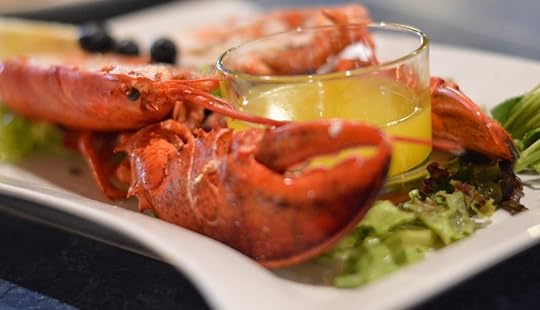
Photo: Seabra Marisqueira/Shutterstock
Seabra’s Marisqueira: Specializing in fresh seafood like lobster, clams, and prawns, Seabra’s Marisqueira was founded in 1989 to carry on Portugese culinary traditions in New Jersey. The restaurant prides itself on making all of its seafood dishes from scratch using fresh catch. It’s known especially for its garlic shrimp, and if you make a reservation, expect to hear mostly Portuguese — and very little English — at the neighboring tables.
Where: 87 Madison St, Newark, NJ 07105
Adega Grill: Adega means wine cellar in Portuguese, so expect to be treated to a cozy atmosphere and extensive wine list. The cuisine itself mixes Spanish and Portuguese influences, and features classic dishes like garlic shrimp, calamari, baked clams, and an impressive selection of grilled steaks. A pitcher of red sangria should accompany your meal.
Where: 130 Ferry St, Newark, NJ 07105
Fernandes Steakhouse: This restaurant blends Brazilian, Portuguese, and Spanish cuisines. It’s speciality is rodizio, Brazilian rotisserie-style grilled meats. Located on the edge of Ironbound, the restaurant is a neighborhood staple and favorite among locals. It shouldn’t come as a surprise that you should order a steak and meat skewers here.
Where: 158 Fleming Ave, Newark, NJ 07105
Sabor Unido: This Brazilian-Portuguese restaurant has exceptional Brazilian feijoada, pork, and black bean stew. The restaurant’s name means “united flavor,”a nod to the way the menu highlights dishes from both Brazil and Portugal. A Brazilian couple and their son run the restaurant’s daily operations, making it a true family-owned affair.
Where: 77 Jefferson St, Newark, NJ 07105
PortuCale Restaurant & Bar: PortuCale is committed to using staple ingredients of Portuguese cooking in all its dishes, especially olive oil, tomatoes, onions, garlic, and wine. The restaurant also incorporates ingredients from former Portuguese colonies, including “hot peppers from Africa,” and “cinnamon, cloves and ginger from India,” making it one of the most traditional Portuguese restaurants in Ironbound.
Where: 129 Elm St, Newark, NJ 07105 
The post This neighborhood in New Jersey has some of the best Portuguese food in the country appeared first on Matador Network.

9 crowd-free coastal vacations in Mexico

Mexico’s most popular beaches can be paradoxical for travelers: Resorts like Puerto Vallarta and Cabo San Lucas instantly tempt us to fly south of the border while their popularity can discourage us from actually going. But avoiding the resort crowds doesn’t have to mean writing off Mexico’s coast. How could it when Mexico’s coastline stretches roughly 5,800 miles across almost 20 states? It all comes down to choosing the right beach town. And we just so happen to know where to find sun, sand, and surf sans crowds. These are nine of our top picks.
1. Puerto Morelos, Quintana Roo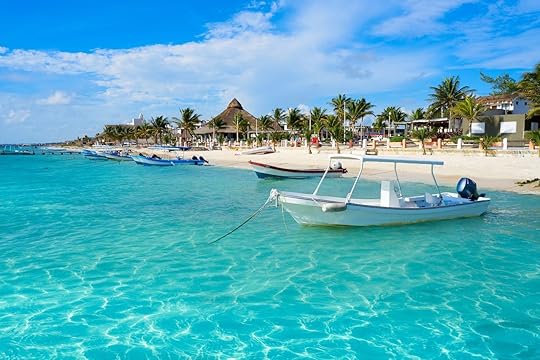
Photo: lunamarina/Shutterstock
Midway between Cancún and Playa del Carmen, Puerto Morelos shares the Yucatán Peninsula with some of Mexico’s busiest resorts. What it doesn’t share are their high-rises. And while the small-town seaport goes to bed well before its neighbors, its waking hours are no less exciting.
It starts with the Mesoamerican Barrier Reef. Feet from shore, snorkelers and scuba divers can swim the calm Caribbean waters with turtles and tropical fish that inhabit the largest barrier reef in the Western Hemisphere. Inland, swimmers can trade corals for cenotes, while the mangroves separating the beach from town make for pleasant scenery on a midday stroll. A walk through the local flea market is also recommended.
After long days outdoors, travelers have their pick of low-rise hotels, seafood restaurants, and beachfront bars to pass the evening. There’s even a surprisingly robust spa scene in Puerto Morelos if hours spent lounging by the ocean just isn’t relaxing enough.
2. Yelapa, Jalisco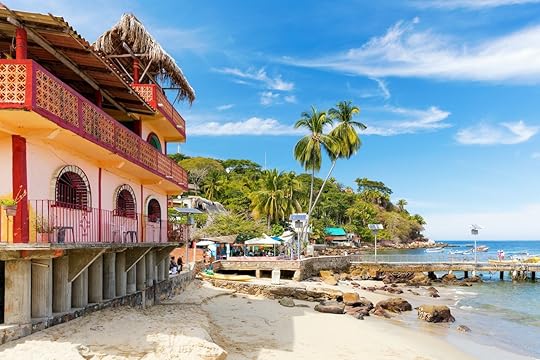
Photo: zstock/Shutterstock
Yelapa sits just 15 miles southwest of Puerto Vallarta. It’s only accessible by boat, however, which has kept the resort crowds at bay. Or across the Bahía de Banderas as the case may be. To visit, charter a boat or hitch a ride on a water taxi from Boca de Tomatlan or Playa Los Muertos. Once there, you’ll be greeted by the Sierra Madres and find mountain passes where roads should be. Hike deeper into the jungle, and you’ll be rewarded with a world of waterfalls.
Yelapa’s crescent beach is small but inviting. Even more enticing is the smell of freshly baked pies that vendors peddle right on the shore. For a true taste of Yelapa, wash down a chocolate, coconut, or tropical fruit pie with a shot of raicilla, an agave spirit that’s similar to mezcal but even stronger. It’s a local specialty.
3. Isla Espíritu Santo, Baja California Sur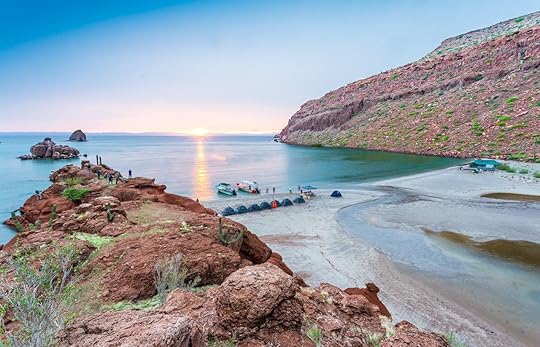
Photo: MIGUEL ZETTER LOPEZ/Shutterstock
Isla Espíritu Santo’s sea lion colony is as close to civilization as visitors will come. In fact, the archipelago’s animal populations are its only permanent residents.
A popular day trip from La Paz, the archipelago turned UNESCO site in 2005 and national park in 2007 can also be an overnight escape for glampers. All they have to do is book with a certified eco-camping outfit like Baja Expeditions or Todos Santos Eco Adventures. From there, it’s a quick trip to Los Islotes to visit the resident sea lions, particularly during spring and summer. The colony is in good company with the birdlife that perches on the archipelago’s cliffs, including blue herons, cormorants, and turkey vultures.
Hiking only reveals half of the archipelago’s fauna, however. Underwater is a world unto itself, teeming with turtles, dolphins, whales, sharks, eels, and fish species ranging from parrotfish to rainbow wrasse. Scuba divers are in for a particular treat. Wrecks like the 60-foot La Salvatierra and 70-foot Fang Ming may be the most exciting places to mingle with the marine life.
4. Maruata, Michoacán
Photo: Carlos Garrigos Saucedo/Shutterstock
Wild, rustic Maruata has been called the most beautiful beach in Michoacán. It’s popular with beach campers who pitch their tents for as little as $1.50 per night. These same backpackers pass their days in hammocks, swinging gently in view of cliffs and cacti. Oceanfront cabanas are also available for roughly $15 per night. Eateries here are simple, primarily thatched palapas serving local catches in fresh-pressed tortillas. Campfire cooking is an alternative provided you hang your leftover grocery haul in food bags to avoid run-ins with free-roaming pigs.
Maruata’s beach is actually three. The eastern beach is best for camping. It’s also the most accessible for swimmers and snorkelers, with the waves getting progressively rougher as you travel west. Where it’s not advisable to swim, visitors can hike the craggy surroundings at low tide. Also worth admiring are Maruata’s handicrafts. The indigenous Nahuatl community is known for its pottery and textiles, producing some of the finest embroidery in all of Michoacán.
5. Barra de Navidad, Jalisco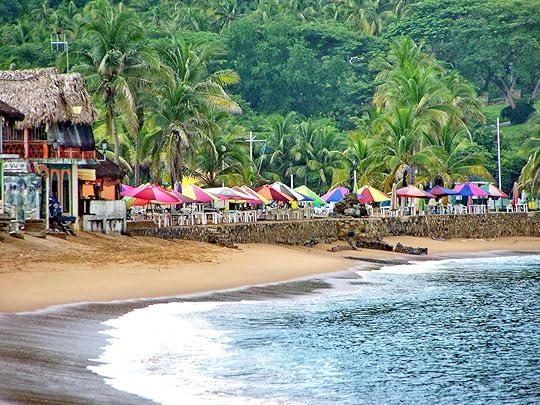
Photo: Angela N Perryman/Shutterstock
This one’s a twofer. An hour up the coast from Manzanillo, neighboring towns Barra de Navidad and Melaque split a sandy stretch of the Costa Alegre. One could argue that Melaque’s share of the shore is prettier, but as beach towns go, it’s all Barra de Navidad.
While much of its charm lies in its sleepiness, the livelier of the twin towns facilitates a variety of activities. Travelers can catch a boat off the boardwalk and test their luck sportfishing for marlin. They can cruise around the lagoon, ride a banana boat, or learn to surf on gentle swells. And at the Grand Isla Navidad Resort, the most luxurious hotel in town, golfers can enjoy a 27-hole course that’s been called one of Mexico’s best.
A moderate expat presence has also brought decent dining and drinking scenes. Think heaping plates of chilaquiles and open mics rather than prix fixe menus, tequila shooters, or DJ sets. But hey, we’ll take local haunt Señor Froy’s over Señor Frog’s any day.
6. Celestún, Yucatán
Photo: Delbars/Shutterstock
Celestún’s appeal is simple: wildlife. The town is surrounded by the Ría Celestún Biosphere Reserve, a wetland of mangroves, dunes, beaches, and rainforest that’s chock-full of migratory birds. Most notable is the flamingo colony that winters there. Fauna like jaguars, ocelots, and spider monkeys also inhabit the jungly mangroves, which visitors can boat through for around $100. And while four species of turtle call the reserve home, Celestún’s own beach is a hatching ground for endangered sea turtles every summer.
Celestún itself is sweet, with a cute town square and a couple of lighthouses. It runs primarily on fishing and salt-making, as evidenced by the boats that float at sea and the salt flats on the outskirts of town. Expect a slow pace of life but prepare for moderate crowds during octopus hunting season, when the population of roughly 6,000 has been said to nearly double.
7. San Pancho, Nayarit
Photo: Jose Moreno/Shutterstock
San Pancho is among the busier beach towns on this list. Digital nomads and snowbirds who own winter homes here are to thank for that. But it’s still a far cry from nearby Puerto Vallarta or even neighboring Sayulita, whose crowd-free days are long gone.
The main beach in San Pancho is long and wide, providing plenty of personal space even during the busier months of November through April. The town is busy but not overly developed: Shops, art galleries, yoga studios, taquerias, and boutique hotels are strung together on cobblestone streets. There’s even a polo club. Travelers can also ride horseback on the beach when they’re not busy surfing, fishing, whale watching, or simply lounging.
Consider renting a vacation home in San Pancho rather than booking a hotel. And whatever you do, sample some birria, or stewed goat, which you’ll see on menus all over town.
8. San Agustinillo, Oaxaca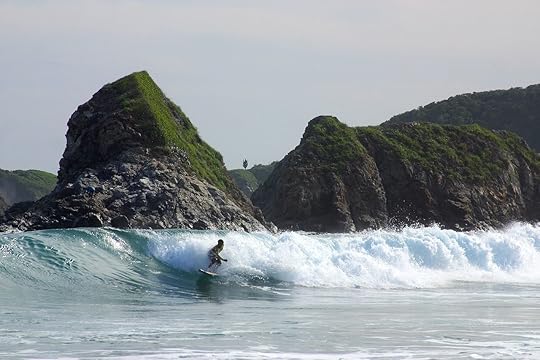
Photo: csp/Shutterstock
San Agustinillo gets less press than neighboring Mazunte, which is not even a mile west but alone bears the distinction of being one of Mexico’s “magical towns.” It’s smaller, sure, with a proportional slice of coast. But its size keeps it quaint. In place of nightlife, there’s a cafe culture. A number of restaurants and hotels here are owned by French and Italian expats, giving this stop on the Riviera Oaxaqueña a lightly Mediterranean feel. Eco-tourism is also a focus.
Generally welcoming to beginner surfers and swimmers, San Agustinillo’s waves can be fickle and at times fierce. Stick to the coves on the west side where the current is most manageable. And at least once before you leave, pass through Mazunte to reach Punta Cometa, Oaxaca’s southernmost point and a stunning sea-view lookout. Sunset visits preferred.
9. Cabo Pulmo, Baja California Sur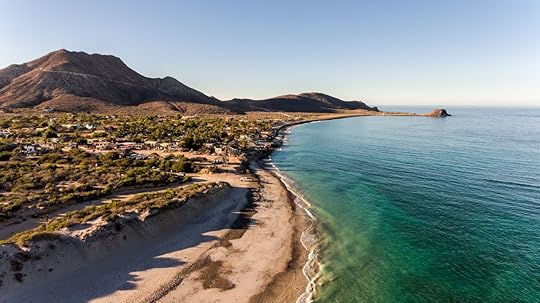
Photo: Leonardo Gonzalez/Shutterstock
Marine conservationists know Cabo Pulmo as a success story. Once threatened by commercial fishing and pollution, the surrounding marine park was federally protected in 1995 owing to the efforts of local activists. It became a UNESCO World Heritage site a decade later and was named a Ramsar Wetland of International Importance in 2008.
The biomass of Cabo Pulmo’s coral reef has since seen more than 450 percent growth. This is good news not only for its sea life but also for those who want to see it up close. Snorkelers, scuba divers, sailors, sea kayakers, and stand-up paddleboarders will appreciate the healthy ecosystem, from turtles, whales, sharks, rays, and dolphins to sea lions and fish species that span the colors of the rainbow. On land, sea birds like osprey also thrive.
The town of Cabo Pulmo is simple but has a handful of haciendas and beach bungalows to accommodate travelers, as well as no-frills taco spots facing the Sea of Cortez. Although nobody would blame you if you forfeited your downtime for dune-filled hikes, appreciating the magic that happens where desert meets sea. 
The post 9 crowd-free coastal vacations in Mexico appeared first on Matador Network.

Act now to sail Croatia on a luxury yacht for an unbelievable price

We hope you love the spaces and stays we recommend! Just so you know, Matador may collect a small commission from the links on this page if you decide to book a stay, and listed prices are accurate as of the time of publication.
Summer is coming fast, and that means it’s time to get those vacation plans in order. This week’s hot Travelzoo deals take us as far as Croatia and as close as Napa Valley, California, with a stop — actually a full-on escape — in Puerto Vallarta, Mexico, along the way.
Cruise Croatia aboard the Zantium New Star or Antaris, from $1649
Photo: Ajan Alen/Shutterstock
When to travel: June-October 2021, June-September 2022
Fully refundable: Yes
The allure of Croatia’s Adriatic coastline draws many lucky travelers from around the world every year, and with this Travelzoo deal, you could join the fun. You and your cabin-mate will sail for seven nights from Split to Dubrovnik, or vice versa, with airport transfer and a suite of luxury amenities, included.
Both Zantium’s brand-new boats, the New Star and the Antaris, are loaded with perks, including a sun deck, pool, bar, restaurant, and personalized service to make your cruise as relaxing and enjoyable as possible.
Aboard, breakfast and lunch are included daily, and you’ll enjoy one special Captain’s dinner. Daily fresh fruit and complimentary Wi-Fi round out this unique, VIP experience on the Adriatic Sea. The boats have a maximum capacity of 38 people, guaranteeing you an intimate experience. This also means your cruise has access to smaller, less-crowded ports throughout the Croatian coast, saving you the hassle of hectic dockings and packed restaurants on-shore.
Daily excursions include exploring Croatia’s national parks, hiking to waterfalls, tastings at vineyards, and walking tours of UNESCO Heritage sites and the cities of Split, Korcula, and Dubrovnik. You’ll also experience the legendary Blue Cave and enjoy an excursion and dinner at Stari Grad.
Have a large group? You can rent the entire boat with a $6,000 deposit, paying the remaining balance due upon date confirmation.
Why this deal is unique:From $1,649 for two people in a private cabin, excursions and most meals includedSeven nights sailing the turquoise waters of the Adriatic Sea, visiting historic sites, nature reserves, and sampling fine food and wineAn intimate, luxury experience that is a world away from the massive cruise linersFour-night escape to The Westin Resort & Spa Puerto Vallarta, $299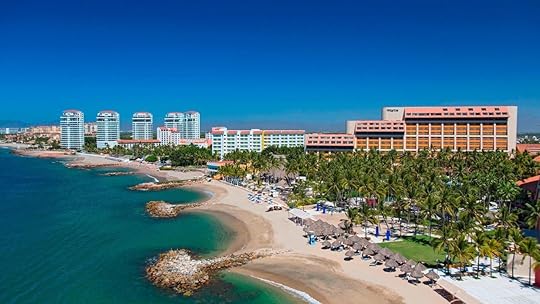
Photo: Marriott
When to travel: April 14-October 28, 2021
Fully refundable: Yes
The pools at the Westin Resort & Spa in Puerto Vallarta are among the world’s most beautiful, set among palm trees and within earshot of the Pacific waves crashing into the sand. This Travelzoo deal puts you and a partner in a partial ocean view room for four nights at a rate of just $299. That’s just $75 per night for a full-on luxury resort experience. You’ll be walking distance from the trendy Marina District, home to a collection of shops and restaurants, as well as one of the city’s best farmers markets.
But with the pools, spa, and fine dining all located on-site, we wouldn’t blame you if you spent the entire trip at the hotel. As you relax in a lounge chair overlooking Bander’s Bay, tropical drink in hand, don’t forget about the rest of us stuck back at the office.
Four-Star La Jolla Hilton in California from $99 per night
Photo: Travel Zoo
When to travel: Through June 11
Fully refundable: Yes
Tucked between Interstate Five and Black’s Beach, the Hilton La Jolla Torrey Pines is SoCal’s ultimate golf and leisure retreat. Visit during the week for rates as low as $99 per night, or on the weekend starting at $139. If golf isn’t your thing, explore Torrey Pines State Natural Reserve, watch the parasailors take off from Black’s Beach, and — local’s tip — enjoy a sandwich lunch overlooking the shore from the cafe near the Gliderport. Keep the resort fee and the parking fee in your pocket, and put it all toward dinner at the hotel’s beautiful restaurant. Pets are allowed at the hotel for an additional cost. 
The post Act now to sail Croatia on a luxury yacht for an unbelievable price appeared first on Matador Network.

Table Mountain wildfires burn down Cape Town university library

A wildfire that began on Cape Town’s iconic Table Mountain Sunday morning has now spread to the University of Cape Town (UCT). So far, the school’s Jagger Library and a campus building containing a prized botanical collection have been severely damaged. Mostert’s Hill historic windmill, private homes, and a restaurant suffered the blaze, too. UCT students and some Cap Town residents have been evacuated.
Additional fires also broke out around Devil’s Peak, a mountain ridge. The first and largest fire is believed to have been started accidentally by a person that is homeless. The cause of each fire is currently being investigated, with arson being suspected. One man was arrested on Sunday for a possible connection with the wildfires, NPR reported.
Firefighters are still struggling to contain the blazes, which are being fueled by high winds. Officials are dousing the flames via helicopters to keep the fire contained, though some areas of the fire are difficult to reach.
According to Ujala Satgoor, the director of libraries for the University of Cape Town, the library’s reading room was destroyed, but the fire detection system prevented the the fire’s spread into other parts of the library.
Unbelievable — the UCT libraries with priceless rare books is being gutted by the #CapeTownFire (Video from WhatsApp) pic.twitter.com/7RI4dsxD3U
— Kimon de Greef (@kimondegreef) April 18, 2021
Table Mountain National Park is asking hikers to leave the area, and motorists to remove their cars, until the threat of the fire has passed. 
The post Table Mountain wildfires burn down Cape Town university library appeared first on Matador Network.

The best Airbnbs in Boston, from Beacon Hill to a ship in the harbor
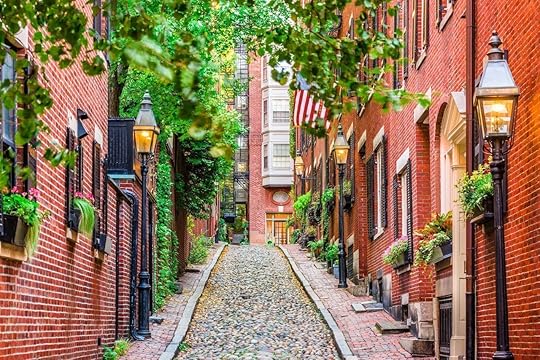
We hope you love the spaces and stays we recommend! Just so you know, Matador may collect a small commission from the links on this page if you decide to book a stay. Listed prices are accurate as of the time of publication.
Boston is one of the oldest and most beautiful cities in the United States. Rivals might tease and say it’s New York City’s cute little sibling, but its compactness is part of what makes it great. No matter where you are, you can easily get to any other neighborhood on foot or on the T, Boston’s public transportation system. And despite its relatively small size, there’s plenty to do. Whether you’re visiting for its rich history, its prestigious schools, or its diverse food scene, there’s something for everyone in Boston. Here are 11 Airbnbs in Boston you’ll be happy to return to after a day of exploring.
Modern European loft near Downtown Crossing
Photo: Airbnb
This beautiful loft couldn’t be any closer to the heart of the city. As you might guess from the name, Downtown Crossing is where everything comes together. All subway lines pass through here, so you can travel anywhere with ease when staying at this Airbnb. It’s an active zone packed with restaurants, bars, shops, etc. The loft has a modern open floor plan with high-end European features and tons of natural light. Its strong WiFi and multiple places to work make it great for remote workers, and you can get a discount for long stays.
Four guests, one bedroom
Price: $230 per night
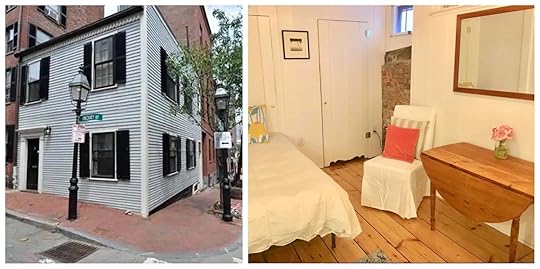
Photo: Airbnb
This private studio apartment was built in 1789 in historic Beacon Hill. Beacon Hill is among the most desirable and expensive neighborhoods in the city, but as a guest, you can experience it for a reasonable price. A few blocks from the apartment is Acorn Street, a cobblestone street lined with colonial brick houses that some consider to be the most photographed street in America (Instagrammers, get your cameras out). It’s also five minutes away from the Massachusetts State House and the Boston Common, the oldest park in America. This cozy apartment is right next to the oldest house in Beacon Hill, allowing you to jump into the past while enjoying modern amenities like a Tempurpedic bed and Roku TV.
Three guests, studio
Price: $142 per night
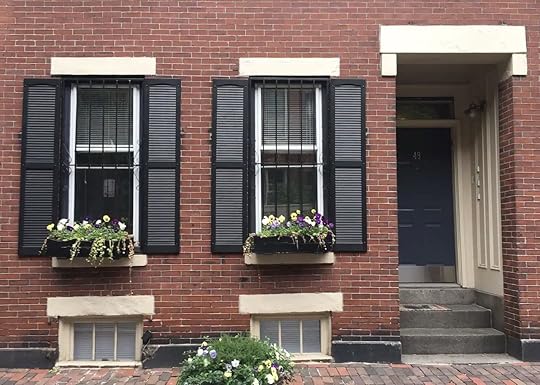
Photo: Airbnb
This centrally located apartment is one of the highest-rated Airbnbs in Boston. It’s right on the border of the Back Bay and South End, two of the most happening areas of the city. The updated Victorian-era townhouse sits on a quiet street that’s close to any public transportation you might need. On foot, it’s 15 minutes or less to the most popular attractions in the city. Walk through Copley Square, grab something to eat at the Prudential Center, get some work done at the Boston Public Library, or shop on Newbury Street. This apartment is perfect for solo travelers and couples visiting for business or leisure. You can also get weekly or monthly discounts for extended stays.
Two guests, one bedroom
Price: $175 per night

Photo: Airbnb
If you’ve ever wondered what it would be like to have an arcade right next to your bedroom, here’s your chance. This private apartment accommodates up to eight guests and is complete with a full kitchen, exercise bike, arcade machine, and vintage pinball machine. The games make an excellent way to reward yourself after a sprint of remote work at the apartment or a day of exploration. The apartment is close to the award-winning SoWa open market. It’s also an easy walk to Copley Square, the Swan Boats in the Public Garden, Newbury Street, and other must-see downtown sites.
Eight guests, three bedrooms
Price: $247 per night

Photo: Airbnb
One of the selling points of this apartment is its location overlooking the city. The place sleeps up to four guests and includes a fully applianced kitchen, although you probably won’t need it during your stay in the North End, where you’ll be surrounded by incredible Italian food. Boston’s Little Italy is home to a large Italian-American population and is known for its outstanding Italian restaurants, cafes, and bakeries (Mike’s Pastry is a must-visit, especially if you love cannolis). The popular New England Aquarium and the famous Faneuil Hall are in close proximity as well, and as the oldest neighborhood in Boston, there’s plenty of history to be seen in the North End.
Four guests, one bedroom
Price: $99 per night

Photo: Airbnb
This one-of-a-kind apartment is small, but it’s creatively designed to make the most of its space. It’s a cozy studio that fully embodies the neighborhood’s hip, bohemian vibe, and it’s perfect for one or two people. Since it’s near both Boston University and Boston College, it’s just steps from some of the best restaurants, clubs, and bars. Allston and its twin sister Brighton are particularly known for their amazing food, especially Asian cuisines. And if you want to travel around Boston using public transportation, it’s a one-minute walk from this apartment to the subway and bus stop.
One guest, studio
Price: $79 per night
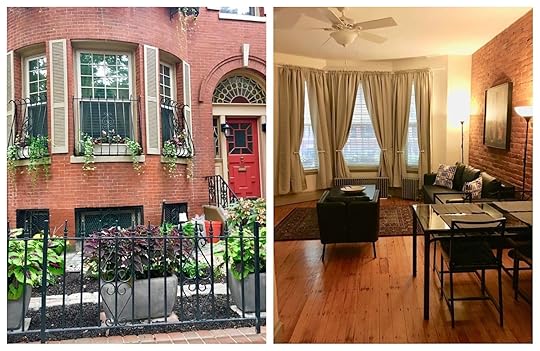
Photo: Airbnb
The Red Sox and the Boston Symphony Orchestra are just two of Boston’s many points of pride. This gorgeous colonial-style brick apartment, which accommodates up to four people and was built in the late 1800s, is the perfect base for catching a game at Fenway Park or attending a performance at Symphony Hall. It’s also close to the world-renowned Berklee College of Music and two incredible art museums, the Museum of Fine Arts, and the Isabella Stewart Gardner Museum.
Four guests, one bedroom
Price: $200 per night
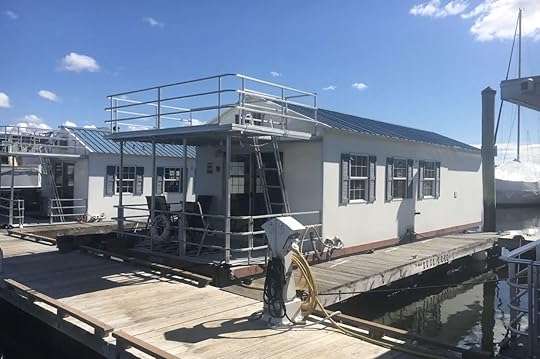
Photo: Airbnb
If you’re looking for something a little different, check out this houseboat at the Charlestown Marina. The boat sleeps up to six people and has everything you need to be comfortable, including a full kitchen, large bathroom, and temperature controls. It’s a 10-minute walk to the USS Constitution, the oldest commissioned naval vessel in the world that’s still afloat today. Keep walking along the harbor and you’ll reach the North End, where you can find the best Italian food in Boston. After a busy day in the city, you’ll be glad to come back to the houseboat where you can watch the sunset on the private sun deck before falling asleep to the gentle rocking of the waves.
Six guests, one bedroom
Price: $216 per night

Photo: Airbnb
Cambridge is a major suburb of Boston that’s right across the Charles River. This Cambridge apartment can accommodate up to two guests and is equipped with many modern amenities. It even has heated floors, which is a godsend to cope with the cold New England winter days. The studio also has a dedicated workstation if you need to get work done during your stay. And if you do have work to do, you won’t be alone. Cambridge is a hub of innovation, technology, and education, home to prestigious Harvard University and MIT. It’s also full of trendy restaurants and cafes, shops, and music venues. This Airbnb is close to all the action. It’s within walking distance of a T stop, too, making it convenient to travel further into the city.
Two guests, one bedroom
Price: $100 per night

Photo: Airbnb
This Pleasure Bay-themed guest suite is part of a bed and breakfast set in a historic South Boston home. It features some lovely original artwork, and it’s just a couple of blocks from the beach and the bus stop. The hosts recommend a walk around nearby Castle Island. This route takes you to Fort Independence, the perfect spot for watching planes from Logan Airport, Sullivan’s Castle Island restaurant, and a path into Boston Harbor. The suite can accommodate a solo traveler or a couple, and there’s a workstation in the room for remote workers.
Two guests, studio
Price: $119 per night

Photo: Airbnb
This large apartment comfortably sleeps 10 people, making it perfect for a group of friends or family. The hosts offer a discount on stays longer than a week, so it’s also a fantastic choice for long-term stays. It has 16-foot-high ceilings, leaving enough room for three loft beds and lots of extra space to hang out or work. One of its two bathrooms comes with a relaxing jacuzzi and rock wall. The apartment is a convenient 10-minute walk to Logan Airport. There are plenty of shops, restaurants, and bars nearby, including the Downeast Cider House taproom. To get to downtown Boston, it’s a short walk to the nearest T station. 
Ten guests, two bedrooms
Price: $271 per night
The post The best Airbnbs in Boston, from Beacon Hill to a ship in the harbor appeared first on Matador Network.

Singapore is building a car-free eco-town covered in jungle greenery

Singapore is building a new “forest town” that will offer an abundance of nature with the promise of improving future residents’ health and well-being. The construction is taking place in Tengah — once a military training ground covered in bricks and concrete — located in the West Region of Singapore.
The eco-town, which is centered around wellness and sustainability, will offer a safe zone for pedestrians to walk and cycle as vehicles will run underground. With an urban area that is free from traffic, Tengah will be the first car-free town in Singapore.

Photo: Singapore Housing and Development Board
Residents will be able to travel to the neighboring towns by bus or via the Jurong Region Line which will be part of the Mass Rapid Transit (MRT) system. A 328-foot-long forest corridor that will run directly through the heart of the town will connect Tengah with a nature reserve and water catchment area, providing a safe passage for wildlife.
Tengah will also offer 42,000 homes to those who would like to live in unison with nature. There will be five distinct districts — Garden, Park, Brickland, Forest Hill, and Plantation. The homes will be located alongside two other developments — the Jurong Innovation District and Jurong Lake District, which are planned to be Tengah’s second business district.
The buildings in Tengah will be covered in greenery and there will be dedicated spaces for community farming. Singapore’s Housing and Development Board is using computer simulations to construct a town that will work alongside the natural environment by accounting for elements such as wind flow in order to minimize heat. The innovative metropolis will also run smart lights that will automatically turn on and off in empty areas to minimize energy usage and waste collection will be transported along a conveyance system offering a more hygienic living environment. 
The post Singapore is building a car-free eco-town covered in jungle greenery appeared first on Matador Network.

April 16, 2021
Where to travel in the US this June

It takes approximately two days after the start of spring before our short attention spans kick in and we start longing for summer. June is the official start of summer, the month when we can lock our scarves, sweatpants, and inhibitions away in a closet for three months knowing we won’t need them anytime soon. It’s also when we start dreaming about a vacation. For many of us, this summer might be the first time we feel comfortable traveling in over a year — so you might as well make it count. Rather than revisit the old standbys, make your first post-lockdown summer vacation in the US special. Whether it’s the islands of the Great Lakes or the beaches of the deep South, there are nine of the best unexpected June destinations in the US.
1. Wolfeboro, New Hampshire
Photo: Micha Weber/Shutterstock
New Hampshire is New England’s playground, and usually, they keep it to themselves. For travelers coming from other parts of the country, New Hampshire’s lakes, forests, and mountains often lose out to the beaches of Cape Cod or the coast of Maine. Make this the summer of New Hampshire — specifically Wolfeboro.
Located right on Lake Winnipesaukee, one of the region’s largest and most beautiful lakes, the small town of Wolfeboro is unsurprisingly an ideal destination for outdoor exploration and leisure. The Cotton Valley Rail Trail is a great place to start. Stretching 12 miles through Wolfeboro, Brookfield,and Wakefield, the trail allows for walking, biking, fishing, and wildlife viewing through wetlands, fields, and beachfronts. Sewall Woods, just minutes from downtown Wolfeboro, has 179 acres of additional trails for those craving a more rugged experience. While the trails are great for exploring the area, chances are you’ll want to spend as much time by the lake as possible. You might be miles from the coast, but there are still several beaches to enjoy. Albee Beach on Lake Wentworth is one of the more secluded, while Brewster and Carry beaches, right on Lake Winnipausake, put you closer to the action.
When you think of New Hampshire, your mind probably doesn’t conjure the rolling vineyards of Napa. But New Hampshire’s wineries have a certain historic, rustic charm you can’t find anywhere else. The Winnipesaukee Winery operated as a dairy farm for over 130 years before becoming a winery. Now you can drop by for a wine tasting, pick up a bottle of their original barrel-aged red, and even spend the night in their guest house dating back to 1810. If the thought of pretending to understand wine is more stressful relaxing, the town’s two breweries might be more your style. Lone Wolfe Brewing Co. and Burnt Timber Brewing & Tavern both have outdoor seating and a range of locally-brewed ales.
2. Montgomery County, Maryland
Photo: Deeper Look Photography/Shutterstock
Baltimore and Washington DC are familiar destinations for travelers, but less so the land in between. Montgomery County, located adjacent to Washington DC and just southwest of Baltimore, is home to cool small towns, wineries, miles of biking trails. The region’s lifeblood is the C&O Canal, which is celebrating its 50th anniversary at a national park this year.
The C&O Canal National Historic Park is a 184.5-mile-long attraction, running through some of the area’s most beautiful scenery. The canal is the product of creative industrialists in the early 1800s who wanted a canal to improve trade and transportation. Surrounding the canal, you’ll find 250 miles of trails perfect for biking, hiking, or even horseback riding. The Billy Goat Trail, which starts and ends on the canal, is one of the most popular. It loops seven miles through forests, rocks, a waterfall, and a log bridge, offering incredible views of the Potomac River.
The canal is also dotted with gorgeous lockhouses. No, lockhouses aren’t a more extreme version of escape rooms. They’re the stone homes where lockhouse keepers used to live and manage the locks. This meant raising and lowering boats between different water levels in the canal. Several original lockhouses, dating back as far as 150 years, still stand today, restored by the Canal Trust. You can even spend the night in the lockhouses, which might be the most unique way to get the full MoCo experience.
The area is also known for its local spirits. Whether wine, beer, coffee, or cider is your drink of choice, Montgomery County has no shortage of options. There’s even a Tastemakers Trail with 20 different stops for locally-made beverages. The Urban Winery in Silver Spring and Brookeville Beer Farm in Brookeville are two of the most popular among wine connoisseurs, while True Respite Brewing Co. in Rockville — one of the county’s larger cities — and Waredaca Brewing Company in Laytonsville are staples of local beer culture. For the nonconformers, Doc Waters Cidery in Germantown has you covered.
3. Mackinac Island, Michigan
Photo: mivod/Shutterstock
Most summer destinations come with the diminishing returns in the form of traffic. Anywhere worth going to, after all, naturally has a lot of people trying to go there. That’s what makes Mackinac Island unique. Located in the middle of Lake Huron, Mackinac Island is a car-free island accessible by short charter flight from St. Ignace, or ferry from St. Ignace and Mackinaw City.
Since Mackinac is a car-free island, you can see pretty much everything by walking. Exploring the historic town itself is enough to keep you busy for a few days. It has several examples of Victorian architecture, two old military forts, period shops like a 19th-century blacksmith, and museums dedicated to the island’s history.
The island’s historic charm is paralleled only by its unique natural beauty. Arch Rock, for example, is the most famous rock formation on the island, forming a picturesque bridge over the water. The Crack in the Island is another great place for enjoying the island’s geography, and a staple of local lore. The massive crack in the island’s limestone foundation looks like the remnants of an earthquake, leaving a narrow schism in the earth. It’s a popular place for picture-taking, and trying to squeeze into the crack without getting stuck. According to legend, the unique geological phenomenon was caused by the Great Spirit Gitchi Manitou, who created the crack by stomping his foot in anger.
All nature activities can be explored by foot, but you might as well fully embrace the historical experience and take a horse instead. Whether it’s a narrated horse-drawn carriage tour through town, or going on an unguided horseback ride through the woods, you can never go wrong by adding some equestrian fun to your trip.
It wouldn’t really be an island vacation if you stick to land the entire time. You can rent kayaks and sailboats to explore the surrounding waters, embark on a fishing expedition, or take a more relaxed approach with a sunset cruise. True to its name, the Sip N’ Sail Cruise is a booze cruise under the scenic Mackinac Bridge, where you can enjoy heated cabins and views of the island’s Victorian-era homes.
4. Grand County, Colorado
Photo: marekuliasz/Shutterstock
Trying to decide which town to use as a base for your Rocky Mountain adventure is like trying to narrow down the options at Cheesecake Factory. Well, let us make the decision easier. Grand Lake, just a few minutes from the entrance to Rocky Mountain National Park, is not only the ideal launchpad for a weekend in the mountains — it’s also the most quintessential mountain town you could ever hope for.
Originally settled in the 1800s as a village for miners and hunting guides, Grand Lake retains the aesthetic appeal of its silver rush roots. It’s part Colorado hipster paradise and part Wild West Disneyland. The streets of the lakeside town are lined with 19th century saloon-type bars, BBQ joints, candy stores, and more ice cream shops than you could possibly imagine.
The main event of Grand Lake is, of course, the lake. Not just Grand Lake itself, but also nearby Shadow Mountain Lake and Granby Lake. You’ll be able to rent paddle boards, pontoon boats, or kayaks to take out on the water at Grand Lake Marina, located right in the center of town. Lake Granby, just a 10 minute-drive away, has several campgrounds along its shores for those looking for an overnight lakeside excursion. If you’re lucky, you might even spot some antelope, moose, or elk.
Staying on the doorstep of the Rocky Mountains would be wasted without visiting the mountains themselves. Just a five-minute drive from town is the park’s entrance, where you’ll find an abundance of elk, mountain goats, sheep, moose, and even bears and wolves. Campgrounds and hiking trails are scattered throughout the park for more rugged adventurers, or you can simply take a leisurely and picturesque drive on the Trail Ridge Road through the mountains to Estes Park. For a more luxurious overnight experience, book a stay in the extravagant Grand Lake Lodge at the entrance of the park, which is celebrating its centennial (a year late, thanks to COVID).
If you go to Colorado and don’t leave completely covered in mud, did you really go to Colorado? Take a UTV tour in Winter Park and you won’t have to ask yourself that question. Just under an hour’s drive from Grand Lake, Winter Park is known for its scenic Corona Pass Road, which climbs 12,000 feet into the mountains. Grand Adventures offers group UTV tours up the road, along a 15-mile route with unparalleled views of the Continental Divide and Fraser Valley. You’ll be following a historic railroad from the early 1900s in your off-road vehicle, and yes, it’s exactly as nail-biting as it sounds. Wear clothes you don’t mind getting completely mudstained.
5. Tillamook, Oregon
Photo: Jennifer Bosvert/Shutterstock
The Salish tribe named Tillamook “the land of many waters,” and that’s not a misnomer. Tillamook, Oregon is an hour-and-a-half due west of Portland, right on the Pacific Ocean, and it’s all about water-based activities. Start at the beach on the Bayocean Peninsula, one of the most secluded beaches on Oregon’s coast. The beach was once home to an oceanside resort community called Bayocean, and signs and markers still remain showing where the original cabins, homes, and restaurants once stood.
The nearby Cape Meares State Park and National Wildlife Refuge is home to some of the largest nesting seabird colonies in North America, as well as the shortest lighthouse on the coast. Once you’ve seen the seabirds, take the short trail through the woods to the “octopus tree” — the largest Sitka spruce tree on the coast.
To dive even further into the area’s natural beauty, check out Munson Creek Falls State Natural Site. This state park is most widely known for the Munson Creek Falls, a 319-foot waterfall and the tallest in the Coast Range. A trail wanders alongside Munson Creek, bringing visitors to some pretty impressive panoramic views of the waterfall.
June is also the first month of the Tillamook Farmers Market, which runs all summer through September. Located on the corner of Laurel Avenue and Second Street in downtown Tillamook, the old-fashioned farmers market is regionally famous for its locally-grown produce, handmade and artisan crafts, baked goods, and even live music. It’s held every Saturday at 9:00 AM to 2:00 PM
Museum aficionados will find plenty to occupy their time in Tillamook, especially at the Tillamook Air Museum. Located just south of the city, the museum is housed inside a former US Navy blimp hangar, and contains one of the country’s best collections of private World War II aircraft. For history buffs, head over to the Tillamook County Pioneer Museum, which explores the historic past of Tillamook County all the way back to the pioneer era.
6. Sedona, Arizona
Photo: Sean Pavone/Shutterstock
Less than two hours north of Phoenix, Sedona is a small town that can serve as the centerpiece for a big trip. Known for its views of Arizona’s red rocks, hiking and biking trails, and abundance of outdoor excursions, Sedona is ideal for travelers searching for a true Southwest adventure.
Sedona might have only 10,000 residents, but there are over 300 miles of hiking and biking trails to explore in the area. The West Fork Trail is one of the most popular. With 13 stream crossings, it’s just over six miles round trip, bringing you through forest and red rock scenery. The Fay Canyon Trail in West Sedona is perfect for beginners. The out-and-back trail is just over one mile each way, offering flat hiking through a shay canyon. The Devil’s Bridge Trail, however, might be the most picturesque trail in Sedona. The Devil’s Bridge is the largest natural sandstone arch in Sedona, accessible via a four-mile trek popular with hikers and cyclists. At the end, you’ll have earned views of the arch and even the chance to step out onto the natural bridge itself. Just be sure to wake up super early to hike before the main heat of the day.
Speaking of that heat, it’s no secret that Arizona in June is hot. Rather than cool off in a nondescript air-conditioned hotel room, take a dip at Slide Rock State Park. Jumping in the river here is a popular way for visitors to cool off. The Verde River is also a great place to splash around in the summer. Sedona Adventure Tours offers kayak, paddle board, and tubing rentals and tours on the river.
For those who would rather enjoy the scenery by car, that doesn’t mean you have to contain yourself to the highway. Pink Adventure Tours offers jeep excursions through the Sedona backcountry. That includes some of the area’s most iconic attractions, like Antelope Canyon and even the Grand Canyon. Other companies, like A Day in the West, combine jeep tours with other fun activities like horseback riding, wine tasting, and helicopter tours.
7. Bemidji, Minnesota
Photo: Edgar Lee Espe/Shutterstock
Minnesota is known for its friendly people, distinct accents, and frigid winter temperatures. In June, you can comfortably enjoy the attitudes and accents without the biting cold weather. Not only is Bemidji located on a quiet lake, it’s also known as the “first city on the Mississippi.” Indeed, it’s the northernmost town on the mighty river, defined largely by its small-town atmosphere and the beauty of the surrounding nature.
The Mississippi begins in Itasca State Park, a 25-mile drive south of town through the woods Visitors can cross the Mississippi headwaters at Lake Itasca by bridge or on stones, and view interpretive displays of the park’s history. Boat excursions and rentals are also available. For a similarly relaxing lakeside experience, check out Lake Bemidji State Park seven miles north of town. Here you’ll find hiking trails, a boat launch, and a short bog walk known for its flower blooms.
Truly a city of monikers, Bemidji is also known as the “birthplace of Paul Bunyan.” You won’t find the fabled lumberjack on the 115-mile Paul Bunyan State Trail, but it’s still worth exploring for its sheer size. It extends all the way to Crow Wing State Park in Brainerd, and can make a perfect full weekend or half-day excursion, depending how far you want to cycle. To really lean into the Paul Bunyan aspect of the town, visit the man himself — and of course, his blue ox Babe — on the shores of Lake Bemidji. The 18-foot-tall lumberjack and 10-foot-tall ox are among the most frequently photographed roadside attractions in the US.
Apart from the giant blue ox, one of the area’s most unique attractions is the Concordia Language Villages — replicated Finnish, Spanish, French, German, and Norwegian villages north of town, in the Buena Vista State Forest. Strolling through the villages feels like walking through a foreign country, but they’re not just for show. The villages host nationally recognized language and cultural immersion programs for adults and families, imbuing your trip with an international flavor.
8. Wilmington, North Carolina
Photo: Paul Brady Photography/Shutterstock
In 2018, Hurricane Florence flooded Wilmington and sent the area reeling. There are few better comeback stories in tourism. Wilmington has managed to maintain its historic character in spite of this immense hardship, and its riverfront district is thriving once again. Wilmington’s epicenter is its historic downtown, running inland from the Cape Fear River. The best way to experience it by land is with an old fashioned horse-drawn carriage ride, or by water with Wilmington Water Tours on the river.
The Riverwalk is the most distinctive feature of downtown Wilmington. Originally designed as a way to generate more interest in the waterfront region of the city’s downtown, the Riverwalk now covers a mile of boardwalk sandwiched between the river on one side and pastel-hued shops and historic structures on the other. It provides access to attractions like the USS North Carolina Battleship and the Cotton Exchange shopping district, and comes alive at night with its restaurant and bar scene.
Wilmington’s character is defined largely by its Victorian architecture, evident in its stately mansion homes. Bellamy Mansion has stood since just before the Civil War, while the beautiful Zebulon Latimer House, built in 1852, now serves as the headquarters for the Lower Cape Fear Historical Society. The Burgwin-Wright House and Gardens and Gardens is one of the city’s oldest mansions, dating back to 1770. All three homes are open for tours. To stay immersed in a Victorian-era fantasy, head east to Airlie Gardens, with sculptures, ponds, flowers, trees, and historical buildings situated on 67 waterfront acres.
For all its historic charms, Wilmington is also a popular beach destination, with three beach towns nearby. Wrightsville Beach is known for its action-packed vibe, including watersports, shopping, and cruises. Carolina Beach is a family friendly getaway with a boardwalk and state park, while Kure beach is the quietest and most relaxing.
9. Mobile, Alabama
Photo: Bob Pool/Shutterstock
For some of the country’s best beaches, you’ll have to look beyond the Pacific and Atlantic and head south to the Gulf of Mexico. The home of several beaches, historic districts, diverse wildlife, and the oldest Mardi Gras celebrations in the country, Mobile is one of the South’s best summer destinations.
Mobile Bay should be your first stop. The bay has several beaches along the Gulf, including Gulf Shores and Orange Beach, as well as an island serving as a bird sanctuary. In addition to its importance for bird migrations, Dauphin Island also has a freshwater lake where you can swim, fish, and relax on the beach. Fort Gaines — military ramparts that have stood for 150 years — is also located there. Fairhope might be the best small town from which to explore Mobile Bay. Located on the bluffs of the Eastern Shore, Fairhope is known for its biking, golfing, tennis, and fishing. The Weeks Bay National Estuarine Research Reserve, located nearby, offers guided walks of its fish and crustacean habitats.
The best way to get a sense of Mobile’s character is by walking through its historic districts. The city has seven designated historic districts, each with its own character. De Tonti Square is one of the most impressive, with its Victorian, Federal, and Greek Revival architecture, and clay-brick townhouses dating back to the 1850s. The Oakley Garden District is another area to set your sights, with over 60 blocks of mansions and cottages built between the 1830s and 1930s.
One house you won’t want to miss is the Bragg-Mitchell Mansion, built in 1855. One of Mobile’s grandest mansions, it has a spiral staircase, double parlors, and displays a collection of antiques inside. For a more rural feel, the Bellingrath Estate sits on 16 lush acres just outside the city. It’s known for its gardens, which include 400 types of camellia, the state flower.
You can’t leave the Alabama coast without trying seafood fresh from the Gulf. Wintzell’s Oyster House has been a community staple since 1938, serving up oysters and legendary seafood gumbo. Felix’s Fish Camp and Grill is probably the best place to go for an upscale dinner and an equally upscale view, with window seats looking out across the waterfront. For some classic southern BBQ, and a departure from seafood, check out The Brick Pit. This BBQ joint is known for its smoked pulled pork, rib, and chicken plates. 
The post Where to travel in the US this June appeared first on Matador Network.

Sleep and dine with giraffes at this giraffe hotel in Kenya

You can easily see giraffes on a safari, but we bet you’d also enjoy watching these long-legged animals from the comfort of a luxurious hotel. If you want to get as close as possible to giraffes but don’t want to rough it, Giraffe Manor — where the animals literally crane their necks over your breakfast — is the perfect wildlife experience without actually venturing into the wild.

Photo: Giraffe Manor/Facebook
A small hotel in Kenya’s Lang’ata suburb, just outside Nairobi, Giraffe Manor is home to several endangered Rothschild giraffes. The hotel operates a breeding program to reintroduce breeding pairs back into the wild to ensure the species’ survival. The hotel is set on 12 acres of private land within 140 acres of indigenous forests and dates back to the 1930s.

Photo: Giraffe Manor/Facebook

Photo: Giraffe Manor/Facebook
According to the hotel, “With [our] stately façade, elegant interior, verdant green gardens, sunny terraces and delightful courtyards, guests often remark that it’s like walking into the film Out of Africa.”

Photo:Giraffe Manor/Facebook

Photo: Giraffe Manor/Facebook
However, the main draw is the giraffes themselves, which often poke their necks through the windows every morning and evening, hoping to score a treat for breakfast or dinner. In addition to interacting with giraffes at the hotel, guests can also book a customized safari tour as part of their stay. 
The post Sleep and dine with giraffes at this giraffe hotel in Kenya appeared first on Matador Network.

Washington State will ban gas cars completely by 2030

If electric cars still sound like a novelty to you, that novelty is about to become mandatory in certain states. Washington State just passed a bill requiring all light-duty vehicles made in 2030 or later to be electric.
The “Clean Cars 2030” bill is designed to prepare the state for all-electric transportation and makes Washington the first state to legislatively pass a gas car ban. While Massachusetts and California also plan gas car bans by 2035, Washington’s date for enforcing the policy is the earliest in the country, Electrek reported.
Specifically, the bill bans the sale, purchase, or registration of any on-electric vehicle with a model year of 2030 or later. This bill applies to cars purchased out of state and imported to Washington. Any electrically powered vehicle would be permissible, including fuel cell vehicles powered by an electric motor. It’s important to note that the bill is framed as a set of goals rather than a strict regulation, so the exact parameters will likely change over the next decade.
As more states consider laws like this one, many are concerned about the economic impact of disappearing gas tax revenue. States often rely on gas tax revenue for road and infrastructure funding, which is an issue that will need to be addressed as electric vehicles become more ubiquitous. 
The post Washington State will ban gas cars completely by 2030 appeared first on Matador Network.

Denmark’s new spiraling tower overlooks stunning UNESCO Wadden Sea World

On May 21, a new spiraling tower will open on the west coast of Denmark in the Wadden Sea National Park. This UNESCO World Heritage site has the largest tidal flats system globally, extending along the coasts of Denmark, Germany, and the Netherlands.
The architectural feat is called Marsktårn, or Marsh Tower. It will give visitors panoramic views of the park and its surroundings. The Marsh Tower will rise 82 feet above sea level, looking over the flat marshlands of the park — with a view that stretches over to the city of Esbjerg and the beloved island of Rømø.
The unusual structure in the spiral shape of a corkscrew, which gets progressively wider toward the top, is built using organic materials to emphasize the connection with its natural surroundings. In the park, there is a reception, cafe, and ice cream shop.

Photo: Visit Denmark
The Marsh Tower is designed by the well-known Danish architecture firm Bjarke Ingels Group, which is responsible for many cutting-edge projects around the world. In the fall of this year, the architecture studio will complete a hotel located just up the coast, a 20-minute drive from the tower.
The tower will open its doors on May 21. Visitors can reach the top with an elevator and marvel at the spectacular views. 
The post Denmark’s new spiraling tower overlooks stunning UNESCO Wadden Sea World appeared first on Matador Network.

Matador Network's Blog
- Matador Network's profile
- 6 followers



